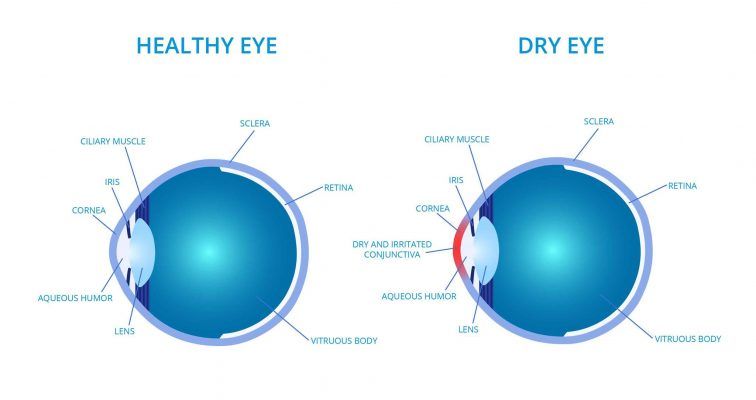Keratoconjunctivitis sicca is the medical term for dry eyes due to impaired tear-film. This is also due to reduced tear production or increased evaporation from the surface of the eye. As a result, the eyes feel dry. According to Tear Film & Ocular Surface Society (TFOS), dry eyes, or dry eye syndrome, are a multifactorial disease that afflicts the tears and the surface of the eye. The condition causes discomfort, visual disturbances, and an unstable tear film and may potentially damage the surface of the eye. The condition is accompanied by the tear film becoming hyperosmolar and causing inflammation on the surface of the eye.1
What’s on this page:
Some have the feeling of having debris in the eye, stinging or the eye feels like sandpaper. Some get wrist wires in the eye, which can cause the eye to become clogged in the morning. The eye may be red so it looks like eye-catarrh. Dry eyes are common with increasing age, and more common in women than in men.2
Dryness in eyes is almost always a lasting condition, as long as they are not due to certain medications. Dry eyes are more prone to sores and damage, for example, in the cornea, than eyes protected by tears. Most people who have mild to moderate ailments live very well with little ailments using artificial eye drops.
What causes dry eyes?
The causes of dry eyes are many. When eyes are exposed to decreased tear production or increased vaporization, it will cause complications. Some of the causes can be addressed, while others are natural reasons. Many reasons can be involved:
- Natural age changes
- Hormonal changes in the body
- Several types of medication can give dry eyes as an undesired effect. Examples of such medications are birth
- control pills and antihistamines for allergy
- Dry eyes are seen in chronic diseases, especially in autoimmune or rheumatic diseases, such as rheumatoid arthritis and systemic lupus erythematosus
- Contact lenses
- Dry eyes are one of the main symptoms of Sjogren’s syndrome
- Vitamin A deficiency (most common in children in developing countries)
- Earlier surgery on the eyes or scarring
- Reduced flash reference or conditions where you can not properly close your eyes

Symptoms
Dry eyes can cause very different symptoms and signs. These symptoms should be noted:
- Sting and pain
- Runny eyes (increased tear)
- Unclear or variable vision
- Red eyes
- Light sensitivity
- Soreness
- Burning feeling
- Sand feeling
- Dryness feeling
- Itching
- Tired eyes
- Discomfort when using contact lenses
Treatment options
You can try to limit the aggravated plagues yourself by being in a room with air conditioning, driving a car with the window open and too much time in front of the computer screen. Protective glasses may be used in situations with known dust / wind exposure, eg cycling. Some will benefit from switching from contact lenses to glasses.
Main treatment for dry eyes is artificial tear fluid in the form of eye drops or gel, even sometimes an ointment. You are then using eye drops and you should drip your eyes every day. There is a different frequency of eye drip, varies with the preparations and how much you are affected. Artificial tear fluid is available on blue prescription.
Most recent studies have shown that omega-3 preparations may have a beneficial effect on dry eyes. It has not been established which dose should be used, so until now, a dose recommended by health authorities should be used.
If the doctor suspects the underlying infection, antibiotics may be tried and in some cases, immune-inhibiting eye drops (cyclosporine) may be helpful.
In case of diminished flashing, a neutral eye ointment and a covering patch at night may be soothing. It may also be advisable to do a small surgical procedure at the eye department.
If there is a particular medicine that is the cause of dryness and you are not completely dependent on it, you might want to try to swap it out or quit. However, this must be decided in cooperation with your doctor.
| Severity | Clinic | Treatment |
| 1 | Mild symptoms | Artificial tear fluid (e.g. eye gel) |
| 2 | Moderate symptoms | As for level 1 supplemented with:
|
| 3 | Serious symptoms | As for level 2 supplemented with:
|
| 4 | Disabling |
As for level 3 supplemented with:
|
When should I go to see my GP?
Dry eyes should be treated if it is disturbing in everyday life. If you are affected with dry eyes, you should conduct a survey with the optician / ophthalmologist with dry eye care. The investigation should be able to reveal causes and severity. Dry eyes should be treated by severity.
Sources:










